last modified: Tuesday, 11-May-2021 09:43:20 CEST
Document status: usable, but incomplete
This chapter presents the most important geological environments in which quartz can be found. Many of these environments result in a characteristic appearance of the quartz specimen.
Note that the way the different geological environments have been grouped is to some degree arbitrary and "quartz-centric", so "definitions" of different environments may overlap and environments may possess similar properties.
Quartz as a Rock-Forming Mineral
This section is now a page of its own:
Quartz as a Rock-Forming Mineral
Vein Quartz
Quartz is often found in veins that cut through rocks. Although the term "vein" suggests this, the veins of quartz and other minerals are usually not thin tubes, but rather thin sheets. The veins can form under various conditions, and depending on these conditions, may or may not contain quartz crystals.
Even though certain types of quartz veins do never bear any crystals, it sometimes makes sense to follow large quartz veins to look for crystal-bearing fissures: Should a rock that contains old large quartz veins have been folded later due to tectonic forces, the quartz veins represented a disturbance (a discontinuity in the otherwise homogeneous mechanical properties), and alpine-type fissures are likely to open up between the quartz and the host rock.
The simplest type of a quartz vein is the filling of an already present crack in rocks. The crack might form during folding of the rock in mountain-building processes, by shattering during tectonic events, by a decrease in pressure during the uplift of a rock, or because a rock cools down and shrinks. Hot brines that percolate the rocks and originate at greater depths with higher temperatures will precipitate the minerals they carry with them in cracks at lower temperatures and pressures. This process may continue until the crack is completely filled or may stop before, leaving "pockets" in the vein that are sometimes outlined by crystals. Hot brines that enter a crack in the rock from some distant hot source like a granite pluton first cool and precipitate most of their load rather quickly. The result is milky quartz, either massive or made of interlocked milky quartz crystals. Later, when the crystal growth slows down, the crystals may get less milky or even clear. In the majority quartz veins, most of the quartz is precipitated as massive, milky quartz. Well-formed crystals, if found at all, are only a small portion of the vein filling.
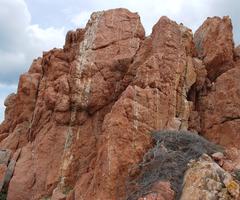
|
Vertical quartz veins in a coarse-grained red granite at Cala Sarraina beach, at the northern end of the Costa Paradiso, Trinità d' Agultu, Sassari Province, Sardegna, Italy. These veins almost always run parallel to the major fracture zones of the large granite batholith that makes up large parts of northern Sardegna and the neighboring island of Corsica.
A close-up view of one of the veins reveals that these are made of intergrown milky quartz crystals. A free standing quartz crystal can be seen sitting in a small pocket in the lower part of the image.
A
small group of quartz crystals that has been worked out of a similar quartz vein at Cala Sarraina beach. Crystals were rarely clear at that location and often included small brown stains of iron oxides.
Another example of vertical quartz veins in a fine-grained volcanic rock of porphyric structure (possibly an andesite) at Monte Santa Miale, north of Seulo, Barbagia, Cagliari Province, Sardegna, Italy. The vein is not massive, but contains small pockets. Like the veins presented in Figs.1.1 and 1.2, it is made of intergrown, mostly milky crystals.
This part of a quartz vein that is outlined with quartz crystals has been found at the foot of the rocks shown in the previous image (Fig.1.3).
This
is a very obvious example of a quartz veins that is not related to the initial formation of the rocks it runs through and is caused by tectonic stress. It is a polished plate of slightly metamorphosed limestone (that is, it has been turned into marble) with a piece of a fossilized coral reef. The rock is of Lower Miocene age. From a marble quarry at Josheghan village, at the southern slopes of the Karkas Mountains, Esfahan Province, Iran.
Rocks are sometimes cut by quartz veins at random orientations, with or without crystals. In other cases there is an obvious pattern in the orientations of the veins: for example, when a igneous rock shrinks during cooling, the cracks may develop into a regular system of fissures that might be filled with quartz from percolating hot brines. The image shows a small pocket with small quartz crystals in an irregular vein in a granitic rock at the Kingston Mountain range in southern California.
A
small piece of the wall of a pocket in a large quartz vein. Small slightly smoky rock crystals have grown in random orientations on the milky gray vein quartz. Different from the veins shown so far these crystals have not been growing from the host rock, but grew in a fissure inside already present, massive quartz vein. From the western slopes of the Inyo Mountains, east of Aberdeen, Owens Valley, California.
Because
hot brines that enter a crack cool rather quickly and precipitate a lot of material in that early phase, many veins show a symmetric zoning. The outer parts bordering the host rock are mostly made of milky quartz while the core is made of more translucent quartz or even clear crystals.
The specimen to the right is a small piece of a hydrothermal quartz vein. There is a brown line running through the base of the specimen that separates two quartz veins that formed successively. It is difficult to say which part is older, the upper or the lower, but if we assume it is the lower, the following happened: A crack formed in the host rock and was filled with hot brines. First milky quartz crystals grew, seen at the base of the specimen and immediately below the brown line. The crystals continued to grow into the gap from both walls, almost filling it out completely (there's a little pocket left near the middle of the lower vein). Note the sandwich structure with a darker core and a brighter border zone. Then the crack widened again, this time much more than before. The crack did not run through the freshly grown crystals, but along the upper border of the vein, along the brown line. Again, hot brines entered the vein and quartz started to grow from the rock walls, this time in two major phases. The first phase of crystal growth is marked by the gray zone above the brown line; note the typical quartz crystal shapes with milky phantoms at the left end of the specimen. In a second phase milky quartz overgrew the older crystals and continued to grow to finally form the rock crystals on top. From the Hakenkrümme quarry, Aue, Sachsen, Germany.
Hot
brines from distant sources may enter the rock in several successive phases, and the result is a pattern of alternating milky and translucent zones. Sometimes colored minerals precipitate along with the quartz and amplify this pattern. Chlorite is often found in quartz veins but its major growth phase tends to be at lower temperatures than quartz, very often when the temperature has fallen so much that the quartz crystal growth wanes. A nice example of a pattern that is caused by successive phases of hot brines entering a crack is the specimen to the right. One can identify three major phases marked by dark green zig-zag lines of chlorite (the last one on the the rock crystals on top of the specimen). In addition one can see a zebra-like pattern of milky and translucent quartz zones. From Langvasseid, Sør-Varanger, Finnmark, Norway.
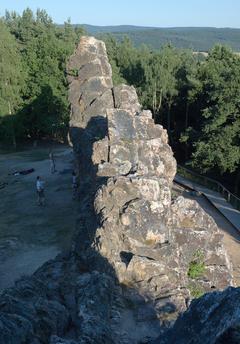
|
Quartz veins can get very large. This image shows a part of the Eschbacher Klippen, a quartz vein outcrop that has weathered out of the softer surrounding rocks in the Taunus mountains north-west of Frankfurt, Germany. Although the rock appears brown, it is almost pure quartz and only superficially stained by iron and manganese oxides. The wall is up to 12 meters high and the central part of a hydrothermal vein system that is 6 kilometers long and almost 80 meters wide. Some of the outer parts of it were initially filled with baryte that was later replaced by quartz.
The central portion that makes up the Eschbacher Klippen consists of intergrown milky quartz crystals. Field of view about 50 cm.
The
rock to the right has been found 100 m north of the Eschbacher Klippen shown in Fig.2.5. Initially, platy baryte crystals had grown in parts of the vein, but later they were replaced by quartz. The platy morphology is still visible in the rock. The gray-green color in the lower right corner is caused by chlorite inclusions. This image is also shown in the milky quartz section.
An even more impressive example is the Bayerische Pfahl (Bavarian stake or pile), an almost straight quartz vein in the Bavarian Forest (Bayerischer Wald) in Germany that extends over 150 kilometers and is up to 100 meters wide. It is, to my knowledge, the world's largest known quartz vein. At some places it has been weathered out of the rock to stand out as a wall up to 30 meters above the surrounding rocks, but it has also been used as a source of quartz for local glass manufactures, so at other places it is a pit instead of a wall. The Akademie der Geowissenschaften Hannover has a nice aerial image of the Pfahl.
Vein
quartz does not have to be white and milky. This specimen consists of smoky quartz, parts of which are almost clear, although there are no crystal faces. The parallel white lines that run through the specimen indicate fracture caused by tectonic activities. From the Turbechepf (or Turbeköpf), Binntal, Wallis, Switzerland.
A more difficult case are occurrences of vein-like quartz lenses in sedimentary and metamorphic rocks. The quartz in them did not grow in already present cracks in the rock. The quartz substance originates in the surrounding rock and has been concentrated in lenses. So the lenses got thicker in time and do not contain any pockets. At the same time, the original layering pattern gets disturbed by the redistribution process and the rocks may assume an undulating or "crinkled" layering pattern. This mobilization and deposition of material from the neighboring rocks in veins pockets and is sometimes called lateral secretion to stress the difference from the deposition of material that has entered the rock in fluids and that originates at some distance. Note that the term lateral secretion also includes the deposition of material in crystal-bearing pockets.
Among the forces that drive the redistribution of the minerals within the rock are apparently differences in the amount and direction of pressure within the rocks (Chapman, 1950). The minerals in the grains of the rock are usually not perfectly-built crystals, but contain a lot of impurities and show many faults in their crystal lattice, like dislocations and twinning. Quartz with impurities and lattice faults tends to dissolve more quickly (Blum et al., 1990) and will thus be easily mobilized and deposited at other places in a purer and more stable form. As their formation involves a local redistribution and segregation of already present minerals, this type of quartz is sometimes called segregation quartz. These veins typically run roughly parallel to the layers of the rocks. It should be obvious that in this type of quartz vein cavities or pockets that bear any crystals cannot form during their formation. However, crystal-bearing pockets may be associated with them, as shown in the section Alpine-Type Fissures or Clefts.
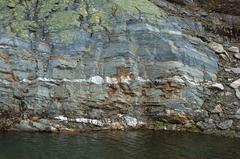
|
Fig. 1.6 shows quartz veins that run parallel to the banding of a metamorphic rock, probably a paragneiss. The veins are up to 50cm thick and consist of massive milky quartz. Seen at the western slopes of Storenuten mountain, north of the Ringedalsvatnet lake at Odda, southwest Norway (field of view about 5-6 m).
Segregation quartz lenses in a schist. Seen at the road SS198 between Mandas and Seui, at the Lago del Flumendosa, Nuoro Province, Sardegna, Italy. The rock has been tilted, and the rocks have been slightly folded, but only on a large scale (field of view about 80 cm)
Seen at the SS198, north of Gairo, Ogliastra, Nuoro Province, Sardegna, Italy. Although the layering of the schist is very disturbed, the rock as a whole has not been subject to shearing or folding, and on a large scale the layers remain horizontal over a large distance (field of view about 1 m).
Parallel veins of segregation quartz run through a partially coarse-grained shist (sometimes locally called gneiss) in a tectonically stressed zone in the southern Aar Massive. At the Grimsel Pass, Kanton Bern, Switzerland.
A close-up shot of a segregation quartz lens from the same location as the preceding photo at the Grimsel Pass. Individual layers get thinner around the milky quartz lense. Also note that there is a sharp border between the quartz and the host rock, no transition zone. Some of the schist's layers run through the quartz lense, indicating that the quartz lens has widened in several phases. This is also proof that the observed pattern is not a
boudinage.
The photo does not show segregation quartz veins, but a metamorphic rock called
migmatite. Sometimes a rock is called a migmatite because of the presence of segregation quartz veins in it, but this is a misnomer: segregation quartz forms at hydrothermal conditions, while in migmatites the segregation of minerals into vein-like structures is caused by partial melting of the rock. The dark and bright components are called
melanosome and
leucosome, respectively, and they are not monomineralic, but composed of different minerals: the leucosome is mostly made of quartz and feldspar and often approaches a granitic composition, the melanosome is enriched in dark minerals, very often biotite. At the Paso Novena (Nufenenpass), Val Bedretto, Ticino, Switzerland.
A detail of the migmatite shown in the previous image. The leucosome looks much more grainy and the borders between the leucosome and the melanosome are more irregular and less well defined than those at segregation quartz veins.
Ore Veins and Gangue Quartz
There are many different types of ore deposits, and depending on their formation, some of them are completely void of quartz, while in others quartz is a characteristic mineral. This paragraph is about quartz occurrences in hydrothermal ore veins. These are cracks in the rock that have been filled with various minerals that precipitated from hot fluids[2.1], some of which are exploited as metal ores.
The veins that are associated with igneous rocks intrusions, like granitic plutons, shall serve as an example to briefly introduce some of the processes that lead to ore vein formation. During the solidification of an intruded magmatic rock body it releases hot watery fluids rich in volatile compounds (HF, CO2, H3BO3) that enter cracks in the surrounding rocks. The cracks are often formed during the intrusion of the magma, and later, when the fluids released from the magma boil and the surrounding rocks are shattered ("hydraulic fracturing"). The fluids carry various compounds from the pluton with them, but they will also dissolve minerals from the rocks they percolate and mobilize metals. Because the temperature falls quickly with distance from the pluton, minerals that got dissolved at high temperatures will precipitate again at greater distance from the pluton. Many ore veins show a characteristic sequence of minerals that precipitated in them with clearly distinguishable, often symmetrical layers. The types of minerals found in a vein change with distance from the pluton body, reflecting the solubility of the various compounds at different temperatures. In many cases, quartz can be found at any distance from the pluton, and often the distant ends of the veins are void of ores and simply filled with quartz.
The terms "vein quartz" and "gangue quartz" are easily confused. Gangue or gang is the term for those minerals in a ore deposit that accompany the ore minerals but are of no value by themselves. Common gangue minerals are quartz, calcite and dolomite. They often occur in a layered manner that reflects the order of deposition of different minerals. Another term for a vein that carries ores and gangue minerals is lode: the "Mother Lode" of the Sierra Nevada, California, is the source of the gold that was found in placer deposits: a quartz vein that contained native gold.
Shiny
pyrite cubes are included in this vein quartz from an old gold mine dump at Arbaz, Valle de Aosta, Italy.
This
is a polished section of a piece of a quartz vein with yellow chalcopyrite and pyrite crystals in several lines that represent different periods of deposition. The left part consists of quartz with an almost fibrous texture that shows some banding due to changes in the chemistry of the fluids. It looks much like agate, but the type of banding here is very different. The right part is fine-grained and chert-like quartz, with a small agate in a cavity on the top. From a mine dump near Boccheggiano, Grosseto Province, Italy.
Milky
and slightly lilac quartz crystals with an artichoke quartz habit sit on an ore matrix composed of yellow pyrite and dark gay galena. Small cuboctahedrons of galena grew on one side of the crystals. The specimen is from Cavnik, Romania.
Octahedral
pyrite crystals on rock crystal. The base of the quartz crystals contains patchy gray-green inclusions of fine-grained pyrite. From Wheal Jane, St. Kea, Cornwall, United Kingdom.
Tiny,
but deeply blue azurite crystals and a thin limonite layer cover these small quartz crystals found in an ore vein in a limestone quarry at Bleiwäsche, Wünnenberg, Sauerland, Germany. Azurite, like malachite, is a copper mineral found in oxidation zones at the roof of ore deposits (the so-called iron gossan), and forms at relatively low temperatures. The orange-brown limonite cover makes the crystals look dull, but underneath the crystals are shiny and clear, and do not contain large amounts of inclusions. In fact, azurite and malachite are unlikely to be found as inclusions in quartz crystals, as they are low temperature products whereas quartz crystals will rarely grow to significant size at temperatures below 100-150°C.
A
classical paragenesis is quartz and hematite from Cumbria, England. The quartz grew as double-terminated rock crystals with a so-called
Cumberland habit on a massive or sometimes bortyoidal hematite matrix and is often accompanied by platy hematite crystals ("specularite"). From the Beckermet Mine, Egremont, Cumbria, United Kingdom.
Quartz
encrusted by green and gray scorodite, FeAsO
4 • 2 H
2O, from a wolframite mine. The scorodite is a low-temperature secondary product that formed at a late stage. Like the azurite shown above, it just covers the shiny crystals superficially and is not included in the crystals. From Seccion Prometedora, Kami, Ayopaya Province, Cochabamba Department, Bolivia.
This
is an amethyst with superficial inclusions of hematite from a pocket in massive green fluorite. From Grube Clara, a baryte and fluorite mine in Oberwolfach, Black Forest, Germany.
Quartz
crystals from ore veins can assume interesting shapes and colors. Here each of the quartz crystals carries small needle quartz crystals that radiate from its prism. They grew together with dark gray sphalerite and brass colored pyrite, note the large pyrite cube in the upper right corner. From Huaron, Cerro de Pasco, Pasco Department, Peru.
Veins and Pockets in Limestones, Marls and Dolomites
This section covers a large variety of different low- to medium-temperature hydrothermal environments found in limestones, dolomitic limestones, marls and related rocks. These are all sedimentary rocks with a major component of carbonates, mostly calcite and dolomite. Although these rocks often contain large veins, these do not fit well in the categories "quartz veins" or "gangue quartz" because they are not dominated by quartz. Veins of massive quartz are absent in these environments.
Sedimentary rocks show many different types of mineralizations along cracks and other openings in the rock. The openings differ in how and when they formed:
-
small to medium-sized cavities formed during diagenesis of the rock
-
cracks formed by tectonic movements after the rock solidified
-
cavities formed by dissolution of the rock either by meteoric waters, for example karst phenomena in humid climates, or by hydrothermal rising waters, for example of magmatic origin.
Often small cavities and tectonically developed cracks get widened by dissolution of the limestone.
Later the watery solutions that percolated the cracks deposited minerals in them, most commonly calcite. Quartz often occurs as small crystals, as isolated double-terminated stubby crystals, but also as druzy oulines of cavities and in irregular intergrowth. Large crystals are only found in conjuction with large hydrothermal veins. Elongated crystals as they are found in Alpine-type fissures or pegmatite pockets are uncommon. The crystals are often stained by inclusions of iron compounds and are often milky and dull. Crystals that grew in isolated gas cavities which formed during diagenesis may be very clear and shiny; the Herkimer Diamonds that are found in pockets in dolomite are an example of this type of crystals.
Many of the specimens presented here come from a "belt" of Devonian and Carboniferous limestones at the northern end of the Sauerland, a low mountain range in Nordrhein-Westfalen, Germany. This belt extends over 150 km from Dornap near Wuppertal in the West to Wünneberg-Bleiwäsche south of Paderborn in the East and is about 20 km wide. There are numerous quartz locations in that area that share many properties and they each show a variety of different quartz mineralizations. This is where the well-known Suttrop-type quartz comes from. The hydrothermal vein formation is thought to be linked to Carboniferous basalt intrusions that occured about 10-20 km south of the locations in Devonian shales. The quartz mineralizations and their relation the geological history of the limestones has been investigated by Behr et al., 1979.
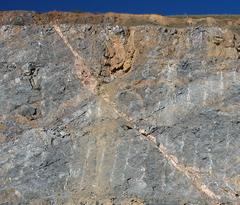
|
Figure 3.1 shows the upper part of a rock wall in a quarry (the field of view is about 30 m). A creme-colored vein mostly made of calcite fills out a crack in the Devonian limestone. The regularly spaced bright vertical lines are traces of drill holes. The layers of the Devonian limestone are tilted and dip to the left with an angle of about 30°. The rock layers on each side of the crack are displaced, the right layers have been shifted downwards by several meters, so this is a
normal fault that runs roughly perpendicular to the strata of the rock. The crack continues further down in the rock, perhaps several hundred meters and thus allows hot brines that originate at greater depth to quickly rise and deposit the dissolved minerals in colder rocks closer to the surface. At its upper third the vein widens, because there is a "step" in the fault. Such a widening and narrowing of a vein is very common and called "pinch-and-swell structure".
There is another common feature of limestones in the image that is more difficult to see: close to the surface, in the middle of the upper edge, are the remnants of a small cave that collapsed and formed a doline. These caves formed by dissolution of the limestone by surface waters. The doline is filled with brown sediments, in this area often sand and very tough solidified mud. In some of these dolines ammonite fossils have been found that originate from overlying Cretacean sedimentary rocks (Behr et al., 1979) which have been eroded a long time ago, so the dolines can be very old and their cavities subject to various types of mineralization in their long history. Authigenic quartz crystals (see below) released from the limestone when it was dissolved sometimes accumulate in these dolines.
The photo has been taken at Bleiwäsche, Wünnenberg, Nordrhein-Westfalen, Germany.
Irregularily
intergrown, stubby, double-terminated quartz crystals together with white calcite crystals grew along cracks in a siderite-limonite matrix that filled a large fissure in Devonian limestone. The crystals are shiny, but contain numerous cobweb-like gas and fluid inclusions. From a quarry at Hohenlimburg-Oege, Hagen, Nordrhein-Westfalen, Germany.
These
shiny gray crystals have grown on creme-colored calcite in a large vertical crack that was part of a fracture zone at a fault in Devonian limestone. The habit and the inclusions of the quartz crystals resemble those of the crystals from Hohenlimburg in the previous image. The outmost layer of the crystals is clear. From Suttrop, Warstein, Nordrhein-Westfalen, Germany.
Small
rock crystals outline a cavity in dolomitized limestone that has been formed by dissolution. Like in the previous specimens, the crystals are stubby and irregularily intergrown and double terminated. The specimen comes from the rock in the lowest part of the quarry that had numerous irregular and independent cavities with calcite, quartz and dolomite crystals. From Hohenlimburg-Oege, Hagen, Nordrhein-Westfalen, Germany.
Double-terminated
quartz crystals in a small cavity in a dolomite/calcite vein in Devonian limestone. The cavity is outlined by pagode-like calcite that is encrusted by limonite. The quartz crystals have a colorless, slightly milky core that got covered by yellow limonite. A second generation of clear, colorless quartz grew on top of the limonite layer, but did only partially cover some of the crystals, leaving a "window" to the core open, which is easier to see in the second, close-up photo. It also shows that sedimentary rocks can produce interesting quartz specimen, too. From Hohenlimburg-Oege, Hagen, Nordrhein-Westfalen, Germany.
A
piece of a cavernous limestone in which the cavities are completely outlined by small artichoke quartz crystals. Here it is even more obvious than in the previous specimen that the cavity formed by dissolution and is not a regular fissure - fissures that open because of mechanical stress would not assume such an irregular shape. From a limestone quarry at Thülen, Brilon, Nordrhein-Westfalen, Germany.
These
intergrown double terminated crystals are examples of the well-known
Suttrop-type quartz, named after the village of Suttrop near Warstein in the Sauerland. This specimen is from Hohenlimburg-Oege, Hagen, however. Quartz of this type can be found at many places in Devonian limestone at the northern border of the Sauerland (see
Behr et al., 1979, and
Jahn, 2002). The crystals themselves are younger and formed probably during the late Paleocoic age in a hydrothermal environment. They are characterized by a pseudohexagonal, double terminated habit and a zonar inner structure reflecting a rhythmic growth. Both geyser-like rhythmic movements of water and tectonic events have been discussed as a cause of the zonar pattern. The mineral anhydrite, CaSO
4, was incorporated at relatively high temperatures; later some of it was dissolved at lower temperatures (anhydrite is more soluble at lower temperatures), leaving tiny cavities in the crystal that contribute to its white color. Interestingly, overall the temperature during crystal growth increased with time, starting at about 60-80°C and ending at above 120°C, perhaps even above 300°C (
Behr et al., 1979), which is very different from the typical development of quartz from Alpine-type fissures, for example. The crystals have a very high number of fluid inclusions, consuming up to 10% of their volume. Accordingly, the crystals have a lower specific gravity than usual. They also never show any accessorial faces. Large aggregates of randomly intergrown, equally sized, double-terminated crystals are common. Quartz of the type "Suttrop" should not be confused with the so called "authigenic quartz" also present at and typical for the same locations, as they differ in formation and properties.
An
aggregate of intergrown stubby, double-terminated Suttrop-type quartz crystals found at Bleiwäsche, Wünnenberg, Nordrhein-Westfalen, Germany, at the locality shown in Fig.3.1.
A rock wall made of marl in an old quarry at a location known as "Maibolte", near Lemgo, Nordrhein-Westfalen, Germany. This is a location for pyrites (so called "iron cross twins") and quartz crystals. The rock wall is made of alternating layers of blocky marl (yellow, brown and - not visible here - green-gray) and thinner gray layers that are mineralized. The distance between two of these layers is about 50 to 80 cm.
A close-up on one of the gray layers in the same rock wall, the field of view is approx. 30 cm. These consist of a soft and crumbly marl with elongated irregular pockets outlined with quartz and calcite crystals. The walls of the pockets are mineralized with quartz, dolomite and calcite and are much harder than the marl; often they can easily be separated as individual geode-like pockets. They are sometimes considered as
concretions in marl, and the fact that they line up in certain layers points to a formation during the diagenesis of the sedimentary rock. However, they do not consist of the same material as the embedding rock and should therefore be called
nodules, somewhat related to flint nodules.
A
piece of one of the pocket bearing layers from Maibolte. The tough gray walls of the nodular pockets consist mostly of intergrown calcite grains with elongated quartz crystals in between and have a well defined outer boundary. Sometimes the nodules' outer surfaces are covered with numerous limonitized pyrite crystals.
The
small quartz crystals in the pockets are not stubby, like most quartz from sedimentary rocks, but elongated, with an "Alpine" look. Some of them show s-faces, like large central crystal in the image, with a narrow dark rhomb-shaped s-face on the upper right edge of the frontal prism face. From "Maibolte", near Lemgo, Nordrhein-Westfalen, Germany.
Occasionally
single scepter quartzes can be found in this type of pockets in nearby locations. The scepters are called "Schaumburger Diamanten" (Schaumburg diamonds), and are also presented on the page about
Diamonds.
This specimen is from the Taubenberg at Hohenrode, Niedersachsen, at the so-called location "location Nr.11". The yellowish crystals are calcite.
Authigenic Quartz
Quartz crystals with well developed faces that grew within a solid rock (and not in some type of pocket) or during the diagenesis of the rock are called
authigenic. This term is often used in sedimentary petrology to distinguish crystals that grew in place from
detrital grains that formed somewhere else and were deposited as a sediment. It sounds strange, but crystals can grow inside a rock. There are two possible mechanisms for crystal growth within solid rock.
- If the rock is relatively soft, or not fully solidified (during diagenesis of a sedimentary rock, for example), mineral grains might get pushed aside by the growing crystal. Minerals that are very soft tend to incorporate the surrounding mineral grains, as you can see in "desert roses" made of gypsum that grew in sand.
- A growing crystal exerts a force on mineral grains in the host rock. Many minerals show a dependency of their solubility on pressure. Upon directional pressure mineral grains in a rock may change shape - not because they get deformed, but because material gets dissolved at crystal faces that lie perpendicular to the direction of the force and recrystallizes at the faces that lie parallel to the direction of force. This is also true for quartz, and quartz grains in sedimentary and metamorphic rocks tend to flatten out upon directional pressure - this is one of the reasons why slates and schists assume a layered structure.
So a growing crystal can cause the bordering mineral grains to be dissolved. For this mechanism to work the rock must be at least a little bit porous, so the material can be transported along water-filled capillaries in the rock.
Many minerals grow like that, for example, at many locations garnet crystals sit inside the host rock, and in some limestones one can find perfect cubes of pyrite. In quartz, this mode of occurrence is not so common and much less known, in part because the crystals are mostly very small and not as shiny as crystals that grew in a pocket, so they are not that interesting to collectors, and in part because they are simply very well hidden in the host rock. Such quartz crystals are only found in certain sedimentary rocks like limestones and gypsum deposits, in which they form at relatively low temperatures, often during diagenesis.
Authigenic quartz can occur as clusters of crystals, sometimes with a bizarre look, or as single double-terminated crystals, or as a combination of both. Often they are a bit dull because the crystal faces bear a lot of indentations. The roughness of the crystal faces can vary systematically at certain locations; for example, "Pecos diamonds" found in Permian gypsum deposits in New Mexico, tend to have shiny rhombohedral and dull prism faces (Albright and Lueth, 2003). Authigenic quartz crystals are apparently never be perfectly clear, and inclusions of fine-grained materials, in particular iron compounds and organic material, are common.
In petrology, the term "authigenic quartz" is also used to denote newly formed layers of quartz that overgrew on an older detrital quartz grain. Given enough time these usually worn, rounded grains may then develop into well-formed euhedral crystals. The term may then also be used for microcrystalline forms of quartz.
This
aggregate of black quartz crystals grew along a small crack inside a Devonian limestone. The crystals were all pointing into the surrounding limestone that has been partially dissolved by hydrochloric acid to show the crystals. Although the crystals are almost black, this is not smoky quartz - the color is caused by inclusions of "bitumen" that formed from organic debris that was buried in the marine sediments. The specimen is from the Lahrmann quarry at Meschede-Rösenbeck, Sauerland, Germany.
A
small quartz hedgehog etched out of limestone from the same location as the previous specimen. The crystal faces are not as shiny as usual as they are roughened by a lot of small indentations of mineral grains in the host rock. Again, the black color is caused by inclusions of organic material ("bitumen"), and not irradiation. Nevertheless these and similar crystals from this and nearby locations are often incorrectly called morion or smoky quartz in the literature on the locality. This can be very confusing, as indeed light-colored smoky quartz
can be found in this area.
Another
more irregular aggregate of quartz crystals etched out of limestone from the same location.
A
larger aggregate of four shiny quartz hedgehogs that have been etched out of a Devonian limestone, from a locality that is well known for these quartzes, Bleiwäsche quarry, Wünnenberg, Sauerland, Germany.
From
the same spot in Bleiwäsche as the previous specimen a little quartz hedgehog, still inside the limestone matrix.
The
red "Jacintos de Compostela" are discussed in more detail at the
Ferruginous Quartz section, but as they are also authigenic quartzes, they are presented here, too. The image shows numerous red-brown double terminated crystals in a selenite matrix together with brown aragonite crystals. The specimen is from Chella, Valencia, Spain.
This
cluster of roughly parallely grown authigenic quartz crystals has been etched out of a Devonian limestone and is just 16 mm high. It is from the Allendorf quarry south of Sundern in the Sauerland, Germany. Note the surface patterns on the rhombohedral faces caused by growth inhibition.
Black
authigenic quartz crystals can be found at several places in the Northern Appenines in Italy. Their color is caused by finely distributed inclusions of organic material, "bitumen". This one sits in a matrix of gray anhydrite rock of Triassic age. It is slightly translucent, and its faces are covered with the small growth inhibition scars that are typical for authigenic quartz crystals. It is from Camporanda, Sillano, Garfagnano, Lucca Province, Toscana. Donated by Marco Barsanti.
Another
example of a black authigenic quartz crystal from the Northern Appenines in Italy, sitting in a selenite rock matrix. Its surface is a bit more dull than the previous specimen, perhaps because the matrix is more coarse grained. It is from Monte Rosso near Castelnovo ne' Monti, Emilia Romagna, a locatity that is just a few kilometers north of that of the previous specimen.
Concretions in Sedimentary Rocks
new section, work in progress
A
concretion is a small, usually spherical or ellipsoidal body of rock that sits inside a sedimentary rock. During the early diagenesis of sedimentary rocks the precipitation of minerals from the pore solutions in the sediments is induced by local variations of the chemical environment. The minerals cement the sediment in the concretion long before the surrounding sediments have been compacted. As a result, the sedimentary layers do not run through the concretions: Fig.4.1 shows two concretions in an outcrop of weathered Upper Jurassic shale at Wallenhorst, Osnabrück, Germany. The concretions (often called "Toneisensteingeoden", "clay iron stone geodes", in Germany, because siderite, FeCO
3, is the main component) are much tougher then the enclosing rocks and weather much more slowly, which is typical for many occurrences. Most concretions are small, with a diameter around 5-10 cm, but some may reach several meters.
Very often the cause of the mineralization is decaying organic material that alters the chemistry of the pore solutions. Hence the center of concretions often contain fossils. Because the concretions solidified before the embedding sedimentary rocks were compacted, the fossils often maintain their original shape and volume, whereas those in the surrounding sedimentary rocks get compressed and distorted. The image shows a pyritized ammonite with hollow, limonite-filled chambers in a concretion at Wallenhorst, Osnabrück, Germany. The diameter of the ammonite is approximately 5 cm
[4.1].
Many concretions shrink inside and turn into septarias. These contain small and narrow, often wedge-shaped cavities in which minerals can crystallize freely, most commonly calcite. Although septarias are found at many places worldwide, the mechanisms behind their formation, in particular the shrinking, are not fully understood.
Probably the best known location for quartz crystals in septarias are Rémuzat, Drôme, Rhône-Alpes, and Sisteron, Alpes-de-Haute-Provence, Provence-Alpes Côte d'Azur, both in France. Here septarias are found in Middle Jurassic marls and limestones. The shiny rock crystals from there are known as "Mirabeau Diamonds". Most of them are double-terminated clear and shiny crystals which tend to have a short-prismatic habit. Except for rare cases of s-faces, crystals lack accessorial faces and the prism faces of most crystals show no striation.
This
is a typical opened quartz-bearing septaria from Rémuzat, Drôme, Rhône-Alpes, with numerous shiny "Mirabeau Diamonds". The walls of the septaria are covered with small brown calcite crystals. This classical location is now closed to collectors, but there are other nearby spots that yield septarias.
This
image shows an opened septaria from Sisteron, Alpes-de-Haute-Provence, Provence-Alpes Côte d'Azur. Note the concentric structure of the rock. The large crystal in the photo is a small skeleton quartz. The creme-colored crystals are calcite.
An
example for a crystal with short-prismatic habit and very small prism faces. The crystal sits on calcite crystals, the platy cream-colored crystals are baryte. From Rémuzat, Drôme, France.
A
triangular sector of a septaria found at the same spot as the ammonite shown above, at Osnabrück-Wallenhorst, Niedersachsen, Germany. A single, normal habit rock crystal sits in between smaller sparkling dolomite crystals that cover the septarian walls.
Flint nodules are concretions, too, and - in addition to the fact that they simply consist of microcrystalline quartz - may contain various types of quartz in cavities, most commonly chalcedony and tiny quartz crystals. The image shows a flint nodule with a cavity that is outlined by sparkling amethyst crystals. This rather unusual combination is found in Azaila, Teruel, Aragon Province, Spain.
Pegmatites and Pegmatite Pockets
work in progress
Pegmatites are small to medium-sized rock bodies made of very coarse-grained intergrown minerals. The crystals are in the centimeter range and can reach sizes of several meters. Pegmatites form either from the residual fluids of a solidifying magma or from hot watery fluids released from rocks during metamorphosis. The term "fluid" encloses watery solutions, vapors which are primarily made of volatile components of the magma, and residual melts of high water content. The temperature of these fluids is between 400° and 800°C. The mineralogy of pegmatites is often very similar to that of granites, but sometimes (in so-called complex pegmatites) they also contain minerals that are composed of rare elements that got concentrated in the fluids.

|
Pegmatites are typically found in the vicinity of igneous rock plutons, in particular at the roof zones of intrusions. They can reach considerable sizes but most often occur as small irregular or lens-shaped bodies or as veins inside other rocks. The image shows a vein of granitic pegmatite inside a metamorphic rock (amphibolite?). Compared to the homogeneously colored host rock, the dyke appears very patchy and its bright reddish color reflects its granitic composition. Seen at the northern shore of Seljordsvatnet, Seljord, Telemark, Norway.
This piece of pegmatite rock comes from the vein shown in Fig.5.1. One can recognize large intergrown crystals of pink and creme-colored, opaque feldspar, stacks of muscovite mica blades with metallic shine, and colorless and white, translucent irregular fillings of quartz.
Pegmatites are usually dominated by feldspars, but quartz is often also present in large amounts. An interesting feature of pegmatites is their zonar composition. An outer shell of fine-grained aplitic rock can often be observed, followed by zones of graphic granite (see below) and a core made of very large crystals. Because pegmatites form from hot fluids, they frequently contain gas cavities - "pockets" - in which perfectly formed crystals will grow. Pegmatite veins often lack a zonar structure.
The largest quartz crystals of good quality come from pegmatites: crystals can reach lengths of several meters. Pegmatites are probably also the economically most important quartz deposits, not only because they yield splendid crystals, but also because the crystals are often exceptionally pure. The rock crystal from Minas Gerais, Brazil, that is offered in large quantities on mineral fairs comes from veins and pockets in weathered pegmatite rocks. One quartz variety is exclusively found in pegmatites, albeit very rarely: pink quartz. Another typical and more common product of pegmatites is rose quartz, but it has also been reported to occur in hydrothermal quartz veins. Of the other varieties rock crystal, milky quartz and smoky quartz are fairly common, while amethyst is quite rare. The cryptocrystalline varieties do not occur in pegmatites unless they form in the course of secondary alterations of the rock (chemical weathering). Interestingly, irregular, glassy or rough crusts made of hyalite, an opal, are sometimes found on crystals from pegmatites.
The look of the quartz specimen found in pegmatite pockets very much depends on the chemical composition of the originating magma and the residual fluids. These fluids are very hot and may contain extremely aggressive agents, as hydrogenfluoride, that will readily attack many silicate minerals. Quartz specimen from such pegmatites often show a rough and dull surface, while being clear inside. So if the paragenesis of minerals at a pegmatite location includes minerals that contain fluorine (topaz, for example), one would not expect to find shiny quartz crystals there (although I would not call this a general rule). Smoky quartz from gem pegmatite pockets that yield splendid crystals of beryl and tourmaline are often dull. One should also keep in mind that crystal growth in pegmatite pockets often takes place in a very unrest environment. Fresh, hotter fluids of different composition may enter the rock through crevices several times and partially dissolve minerals that have already grown.

|
This is a view of the Landsverk I pegmatite mine in Evje, Norway, situated in a large pegmatite body. It used to be mined for microcline feldspar and is now a fee collecting site renowned for its nice amazonite. One can find a wide range of minerals, including rare earth element minerals, and, of course, quartz.
A rock wall in the pit shown in the previous image. It contains many pegmatite pockets that are up to 50 cm in diameter. The pegmatite in this quarry does not have a homogeneous composition and accordingly the pockets found at different spots in the rock do not all contain the same minerals, and some only bear feldspar or quartz.
The Kreuzberg church in Pleystein, Bavaria, Germany, rests on a large 35 m high outcrop of quartz, the Kreuzberg mountain. The rock is made of massive smoky and milky quartz. The rock wall facing north-east has been been formed during the exploitation of the quartz in a large quarry. The quartz was used in the local glass and porcelain manufacture. Occasionally large pieces of rose quartz have been found in the rock, and Pleystein is sometimes called "rose quartz town". This is also a famous location of phosphate minerals like strengite and phosphosiderite that were found in pockets inside the quartz (Wilk, 1975).
Between the quartz body and the underlying granite pluton there is a thin layer of pegmatite and aplite rock, and in fact this is as a very large quartz core of a pegmatite body on top of a granite intrusion.
Graphic granite from Landsverk I. The rock consists of feldspar and quartz crystals that are intergrown in an regular and oriented manner that relates to the crystallographic orientation of the crystals, also called epitactic intergrowth (the feldspar is bright and translucent, the quartz is dark and transparent in this piece). This type of rock can only be found in pegmatites.
The more popular explanation of this pattern is the simultaneous growth of the quartz and feldspar crystals from hot fluids and water-rich melts (Fenn, 1986). There are also indications that in certain cases the pattern emerges from a partial dissolution and replacement of feldspar by quartz (Stel, 1992).
Similar looking nodules made of spessartine garnet and quartz, sometimes with epitactic intergrowth, have been found at several localities, for example in pegmatites of the Adamello and Bergell massifs in Italy (Zhang et al. 2001).
A smoky quartz crystal with a large triangular crystal of muscovite mica that consist of many thin shiny blades. Large mica crystals are typical for pegmatites and commonly occur together with potassium feldspar (orthoclase, microcline) and quartz. The specimen is from Itinga, Minas Gerais, Brazil.
While some pegmatite deposits produce splendid and transparent quartz crystals, very often the quartz is badly corroded and milky. The interesting specimen on the photo is from a pegmatite pocket in the Landsverk I mine, and has suffered corrosion and growth inhibition by chlorite inclusions. The crystals resumed growth at a later stage, but the growth could only continue from certain spots on the surface, resulting in strange-looking thin whitish caps of quartz.
A transparent rock crystal on a matrix of feldspar and black tourmaline with a little muscovite mica from a miarole or pegmatite pocket at the Erongo mountains, Namibia. The crystal is still shiny, but shows an unusual surface pattern of crossing shallow grooves on its rhombohedral faces. The entire crystal feels very rough like a grater or a file. Very likely this is the result of alternating phases of dissolution and growth.
An interesting paragenesis from the Landsverk I mine in Evje, Norway, showing slightly corroded quartz crystals with a smoky core and superficial chlorite inclusions at the prisms. The crystals are partially covered by golden-green shiny flakes of the mica mineral stilpnomelan.
This group of quartz crystals covered by small golden flakes of stilpnomelan is also form the Landsverk I mine. The crystals were covering the wall of a small pocket in a large very coarse-grained pegmatite boulder.
It might not look like one, but this is a smoky quartz. Its dark core has been covered by a thin layer of milky quartz with superficial iron oxide inclusions that gives the crystal a silky shine. It is from a tin and tungsten mine at Cínovec, Krusné Hory mountains in the Czech Republic (referred to as Zinnwald, Erzgebirge, in German). Many tin and tungsten deposits are associated with so-called greisen rocks in the roof zones of granite intrusions, which form by alterations of granite or pegmatite rocks by residual hot fluids that have been released from the granite intrusion.
Miarole Pockets
work in progress
Miaroles are gas cavities that formed during the solidification of of intrusive magma to igneous rock, but they are not linked to the formation of pegmatite rocks. Their formation is similar to that of pegmatite pockets, except that they occur within the granite host rock. The segregation of a gaseous phase from the magma can be triggered by a sudden decrease in pressure, for example. Miarole pockets can be considered the analogon of mineralized gas cavities in volcanic rocks. However, they are much rarer than cavities in volcanic rock, because intrusive magma undergoes a very slow solidification process that allows for a gradual differentiation and spatial segregation of different phases. Volatile phases penetrate the surrounding rocks or accumulate in pegmatite bodies. By contrast, in a volcanic lava that carries large amounts of volatile components often many gas cavities form when the gas segregates from the rock at low pressure at the earth's surface.
Crystals formed in miarole pockets grew as a continuation of mineral grains in the host rock. Larger miaroles may contain well formed crystals, not only of quartz, but also feldspars, tourmalines, micas, and beryl. In general, the paragenesis reflects the mineral composition of the host rock more than pegmatite pockets do.
A small miarole in coarse grained granite at Cala Sarraina beach, at the northern end of the Costa Paradiso, Trinità d' Agultu, Sassari Province, Sardegna, Italy. It is just 2-3 cm in diameter. Note the small halo of darker granite around it.
A larger miarole at the same location that has been filled out with pegmatite rock made of red orthoclase feldspar and white quartz. Sometimes there are small pockets within the filling, that's why you see tools in the image, but that one was apparently filled out completely.
A miarole pocket with quartz and microcline crystals in granite. It has an irregular shape and shows a gradual increase in grain size from the host rock to the crystals that outline the cavity. Seen at Rock Corral, east of Milford, Mineral Mountains, Utah.
Morion and feldspar crystals from a miarole pocket in the western Erongo mountains. Well-formed and dark smoky crystals are not that common at the Erongo.
Quartz Caps of Plutons
work in progress
Occasionally a granitic pluton develops a quartz "cap" as a final step in magmatic differentiation. As a granitic pluton cools and slowly solidifies, the remaining magma gets more and more concentrated in water and silica until finally the residual hot watery fluids accumulate at the roof of the plutonic body. These may intrude into the overlying rocks and form large quartz veins or form a massive quartz cap on top of the pluton or its associated pegmatites.
Fig. 7.1 shows a large outcrop of milky quartz that might represent a quartz cap or a very large vein related to a granitic pluton. About 1 km west and south of that position the granite appears at the surface. The white quartz wall in the front is about 2 m high, the whole quartz outcrop measures about 100 by 100 m. The quartz appeared to be completely void of crystals. The photo is taken at the southern slopes of Storenuten mountain, north of the Ringedalsvatnet lake at Odda, southwest Norway.
Geodes and Cavities in Volcanic Rocks
work in progress
Primary Gas Cavities
Elongated geodes filled with quartz varieties in the Steinkaulenberg underground mine at Idar-Oberstein, Germany. The cavities have been stretched while the lava flow was slowly moving, so they are all elongated in the same direction. The host rock is an andesite of Permian age, called a "Latiandesit, Typ Steinkaulenberg" in the local literature (Bambauer et al.). The dark olive green patches are moss commonly found in artificially illuminated caves.
Gas cavities outlined with calcite and quartz crystals in an intermediate volcanic rock, probably a dacite. The picture was taken at a claim north of the small-scale miners camp at the southern end of the Tafelkop mountain in the Goboboseb mountains, south-west of the Brandberg, Namibia.
Andesite blocks in the Juchem quarry, Niederwörresbach, north-east of Idar-Oberstein, Germany. The bright spots on the rocks are quartz-filled gas cavities. On the large block in the front you can see a small amethyst geode.
The Juchem quarry is an active quarry and one of the few fee-collecting sites in Germany and is open to collectors on weekends.
A quartz geode in an andesitic volcanic rock from the Juchem quarry. The quartz crystals are stained brown by coatings and inclusions of iron oxides. The outer layer is made of brown calcite, a by-product of the weathering of volcanic rocks and common companion of quartz crystals in that environment.
This geode in basaltic rock has first been outlined by chalcedony which also formed thin stalactites. Later the chalcedony got completely encrusted by sparkling quartz crystals of Cumberland habit (they lack prism faces). To the right there is a large crystal of calcite, a common companion of quartz in volcanic geodes. From the Deccan traps at Nashik, Maharashtra State, India.
Thundereggs
Thundereggs and similar geodes are found at many localities, and the specimen of each of them show their own peculiarities. At most localities the geodes occur in more or less altered acidic volcanic rocks, like rhyolite tuffs and perlites, they seem to be absent in flood basalts. Very often they contain agate, which will show a color and pattern that is typical for a locality. Some contain rock crystals and amethysts. The silica that is precipitated as chalcedony or as macrocrystalline quartz is not only derived from the free silica in the rock. Many acidic volcanic rocks cool rather quickly, in particular if they are deposited as airborne tuffs, so quick that there is no time for the formation of crystals and large parts of the rock consist of volcanic glass. Lava of rhyolitic or andesitic composition is very viscous and not very hot and because diffusion and thus the redistribution of material is hindered, crystal formation is inhibited and often the lava turns into obsidian, natural glass. Volcanic glass is not stable at surface conditions and is readily altered in a process called devitrification. This process releases a lot of silica that tends to polymerize at low temperatures.
This solidified and altered volcanic tuff contains several cavities that are outlined by chalcedony overgrown by tiny quartz crystals. The cavities are surrounded by zone of red-brown rock, which is in turn surrounded by a thinner olive-green zone. If left in nature, this rock would weather and eventually fall apart and the small thundereggs would be left over. From Potato Patch, Hauser Beds, Imperial County, California.
Although the colors and the texture differ, such a rim is found in all thundereggs, and typically it is highly silicified and tougher than the host rock.
Another thunderegg from the Potato Patch, with botryoidal chalcedony overgrown by quartz crystals. The bump at the lower right is a neighboring thunderegg.
The image shows a thunderegg with a triangular cavity that is outlined by prismatic rock crystals that grew on a thin layer of agate. At the bottom you see a number of rounded structures with a spherulitic growth pattern similar to the one seen in devitrified obsidian. From Hermanas, Luna County, New Mexico.
Donated by William Gallagher.
Blue-gray chalcedony in a septaria with quartz crystals from Utah, very likely from the Dugway geode beds in Juab County. This piece is on the border-line between agate and chalcedony, as it shows a faint banding. If it was more colorful it would probably be called agate. Dugway geodes are known for prismatic rock crystals that occasionally occur in small groups or alone.
These are rock crystals with hematite in a so-called "Schneekopfkugel", geodes from a rhyolite rock found near Friedrichroda in Thüringen, Germany. They are named after a location in the vicinity of the Schneekopf mountain in the Thüringer Wald. This is probably the best-known thunderegg locality in Germany, and one can also find agate-filled geodes there.
Thundereggs may be filled with agates, like this specimen from Sokołowiec, in south-western Poland. The rim is made of a porphyritic rhyolite with many white feldspar crystals and a few rounded gray quartz crystals, similar to the matrix of the Schneekopfkugel in the previous image.
Irregular Cavities
Irregular cavities are sometimes found in crumbly volcanic rocks, like tuffs, perlites and ignimbrites. They may contain zeolite minerals, calcite, but also quartz, both as chalcedony and as crystals. Some of the "classic" quartz localities lie in these rocks.
Chalcedony is typically found in volcanic rocks as a secondary product. The image shows a solidified volcanic tuff in a dry stream bed near Mopah Peak, Turtle Mountains, southern California.
These are four typical manifestations of quartz in volcanic rock cavities on one specimen. There are, from left to right: botryoidal gray chalcedony, radially arranged parallel grown quartz crystals that are often found as a wreath around chalcedony, botryoidal chalcedony with a coating of small quartz crystals, and brown to black chert-like vein-filling of chalcedony. From a fracture zone in rhyolitic volcanic tuff south of Thump Peak, Mule Mountains, southern California.
The flow-forms typical for chalcedony that are likely caused by the movement of silica gels can probably only develop in environments in which silica is released at a large rate. These conditions are most easily met in fine-grained, glassy and silica-rich tuffs. The specimen shows sparkling quartz crystals that have overgrown chalcedony protrusions that resemble snow-covered shelf fungi. It came from a crack in a brecciated rhyolitic tuff at the same location as the previous specimen, Thump Peak, Mule Mountains, southern California.
Sparkling quartz crystals of normal habit grew in an irregular cavity in a vein that filled mostly with quartz and hematite (red-brown patches). The vein developed in a fractured zone in rhyolite rock. Münstertal, Black Forest, Germany.
Osilo, a village on the island Sardegna in Italy, is famous for its pale but evenly colored, clear and shiny amethysts that occur in many different shapes in irregular cavities inside an altered and very crumbly, green-gray rock of presumably trachytic composition[8.1] and amygdaloidal texture. They are often accompanied by small but well-formed gray-green or white calcite crystals and brown siderite. So far specimens that look similar have only been found in Bolivia, and their volcanic matrix looks strikingly similar.
Skarn Zones
new section, construction site
Skarns are a family of calc-silicate-rocks that form when magma intrudes carbonate rocks, like limestones and dolomites. Hot fluids from the magma, often rich in silica, enter the surrounding rocks and cause changes in the mineral composition by the exchange of material and the associated chemical reactions at elevated temperatures. Changes in the mineral composition of a rock by an exchange of large amounts of material is called metasomatosis, whereas changes in mineral composition that are largely due to changes in pressure and temperature are called metamorphosis. So skarns are not metamorphic rocks in the strict sense. The chemical reactions that take place may cause an accumulation of valuable metals in the skarn rock, and certain skarns are important ore deposits and commercially exploited.
Skarns typically form a coat that separates the pluton body from the unaltered carbonate rock. The width of the skarn depends on the size of the intrusion, small magmatic bodies will cool faster and give off a small amount of fluids, and their skarn zones are often just a few meters wide, whereas skarns around large plutons skarns may be around 100 meters wide. Skarns are not homogeneously formed rocks, they show a pronounced zonation. High-temperature silicate minerals like garnets are found close to the igneous intrusion, carbonates are found bordering the limestones. Typical minerals found in skarn zones include garnets (in particular andradite), epidote, amphiboles, hematite, pyrite, wollastonite, and quartz.
Skarn zones are more likely to occur around granitoid pluton intrusions than around volcanic dikes, sills and subvolcanic domes. The reason is that volcanic rocks, in particular those of basic and intermediate composition (basalt, andesite, etc.), are usually very dry and do not release fluids into the surrounding rocks.
These milky needle crystals formed haystack-like aggregates in veins in a skarn zone. Found at Kimmeria near Xanthi, Northern Greece.
One type of quartz is typical for skarns: prase, evenly colored by incusions of green amphiboles like actinolite. The specimen from the three best-known prase localities, Elba (italy), Serifos (Greece) and Dalegorsk (Russia), all come from skarn rocks.
These crystals come from Sinerenskoe, Dalnegorsk, Russia. The color of the quartz crystals is caused by dark green actinolite inclusions, the orange-brown crystals are andradite garnet.
Alpine-Type Fissures
The section has been moved into a separate page, listed under "Special Topics": Alpine-Type Fissures.
Quartz-Free Environments
In certain geological environments one should not expect to find any quartz, either as crystals, massive, or in microrystalline forms. This is mostly determined by the chemistry of the rock-forming minerals in these environments, so this section has been moved to Quartz-Free Environments in the chapter Quartz as a Rock-Forming Mineral
Footnotes
2.1
The term "fluid" encompasses both liquid and gaseous phases.
4.1
This looks all too easy. We have been 5 persons at that locality and split geodes for hours till the ammonite was found.
8.1
The quarry from which these specimens come produced trachyte, but this trachyte is a dark brown, very tough rock that lies underneath the amygdaloidal, crystal-bearing layers. The large amount of calcite present in fissures and cavities indicates a more dacitic or andesitic composition.
 Printer Friendly Version
Printer Friendly Version
Copyright © 2005-2022, A.C. A k h a v a n
Impressum
- Source: http://www.quartzpage.de/gen_occ.html



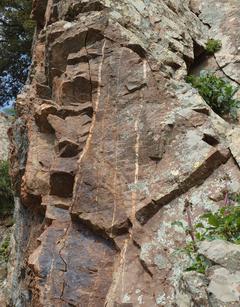
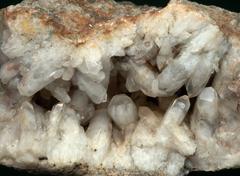
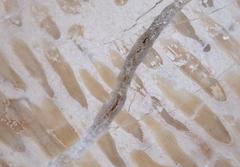

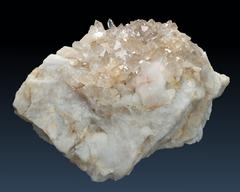




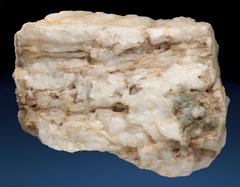
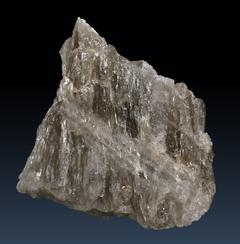

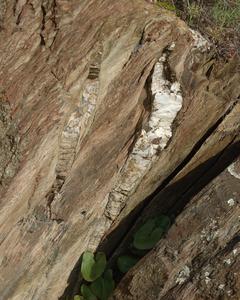

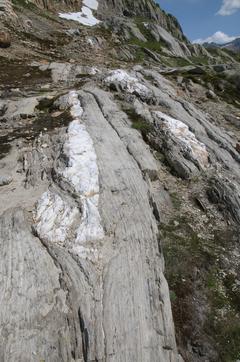




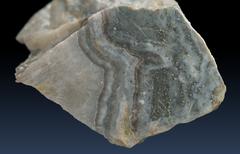

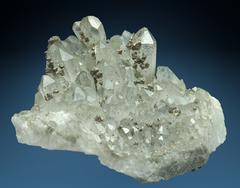
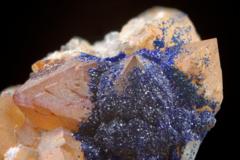







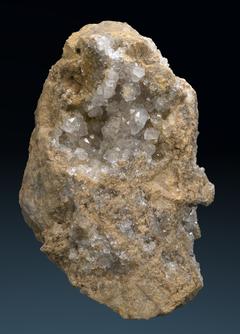

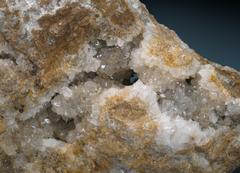



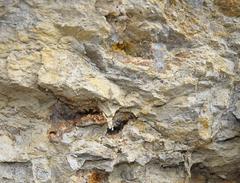
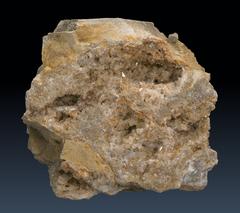
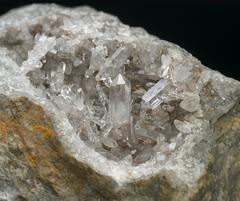
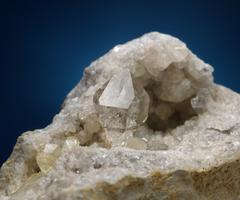

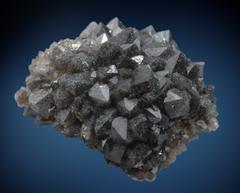
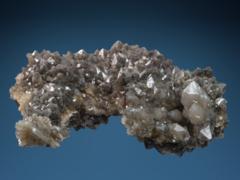



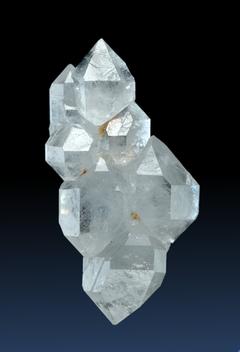


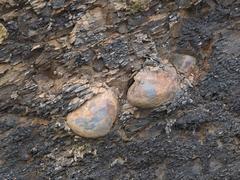
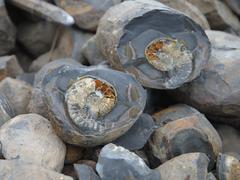

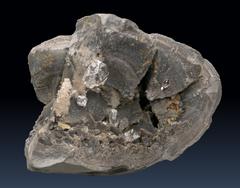






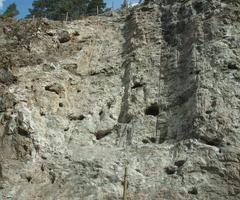
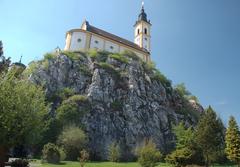


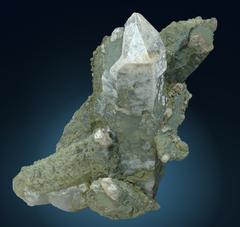
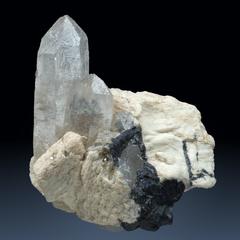






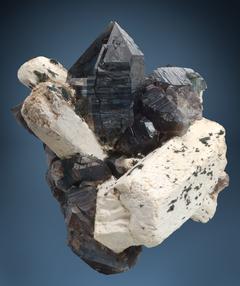

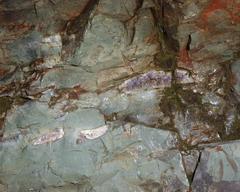
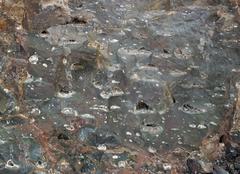

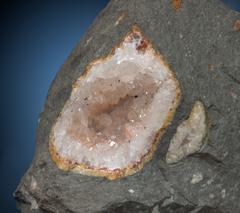


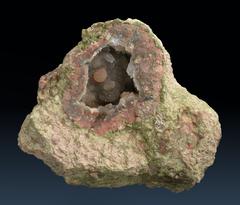
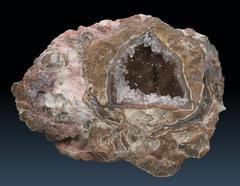
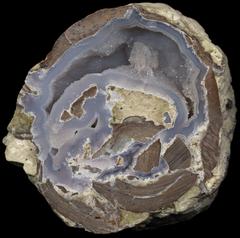

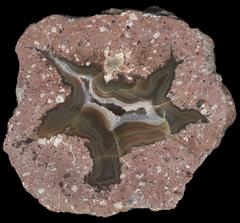

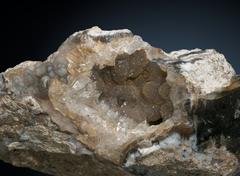
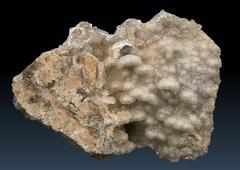
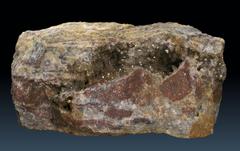

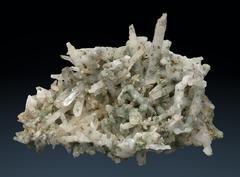
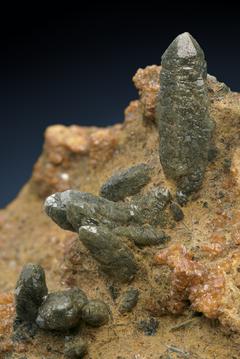
 Printer Friendly Version
Printer Friendly Version
